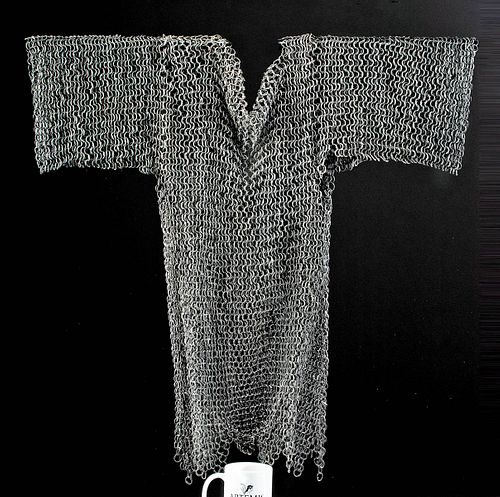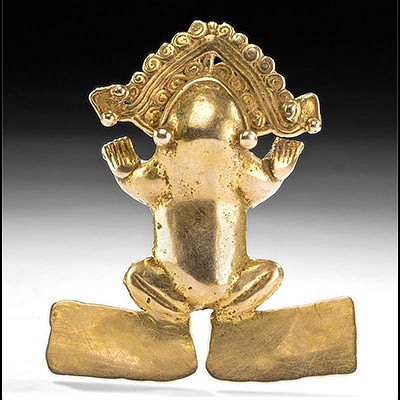Late 16th C. Spanish Colonial Iron Chainmail Hauberk
Lot 128
About Seller
Artemis Fine Arts
686 S Taylor Ave, Ste 106
Louisville, CO 80027
United States
Selling antiquities, ancient and ethnographic art online since 1993, Artemis Gallery specializes in Classical Antiquities (Egyptian, Greek, Roman, Near Eastern), Asian, Pre-Columbian, African / Tribal / Oceanographic art. Our extensive inventory includes pottery, stone, metal, wood, glass and textil...Read more
Estimate:
$7,500 - $10,000
Absentee vs Live bid
Two ways to bid:
- Leave a max absentee bid and the platform will bid on your behalf up to your maximum bid during the live auction.
- Bid live during the auction and your bids will be submitted real-time to the auctioneer.
Bid Increments
| Price | Bid Increment |
|---|---|
| $0 | $25 |
| $300 | $50 |
| $1,000 | $100 |
| $2,000 | $250 |
| $5,000 | $500 |
| $10,000 | $1,000 |
| $20,000 | $2,500 |
| $50,000 | $5,000 |
| $100,000 | $10,000 |
| $200,000 | $20,000 |
About Auction
By Artemis Fine Arts
Aug 13, 2020
Set Reminder
2020-08-13 10:00:00
2020-08-13 10:00:00
America/New_York
Bidsquare
Bidsquare : Fine Antiquities, Ethnographic & Fine Art
https://www.bidsquare.com/auctions/artemis-gallery/fine-antiquities-ethnographic-fine-art-5415
Features classical antiquities, ancient and ethnographic art from cultures encompassing the globe. Egyptian, Greek, Roman, Etruscan, Near Eastern, Asian, Pre-Columbian, Native American, African / Tribal, Oceanic, Spanish Colonial, Russian, Fine Art, so much more! Artemis Fine Arts info@artemisfinearts.com
Features classical antiquities, ancient and ethnographic art from cultures encompassing the globe. Egyptian, Greek, Roman, Etruscan, Near Eastern, Asian, Pre-Columbian, Native American, African / Tribal, Oceanic, Spanish Colonial, Russian, Fine Art, so much more! Artemis Fine Arts info@artemisfinearts.com
- Lot Description
Western Europe, Spain, pre-Spanish Colonial to early Spanish Colonial period, ca. late 16th to first half of the 17th century CE. A substantial shirt of armor known as a hauberk formed from thousands of individually attached chain links. The broad sleeves enabled arms of any size to fit through, and the open front meant it could be worn underneath or atop clothing or armor. The broad, lightweight rings did not hinder the soldier's movements when worn and was highly efficient at mitigating damage from slashing or thrusting blows. Size: 56" W x 27.5" H (142.2 cm x 69.8 cm)
Chainmail like this was an invaluable component of an early Spanish Colonial soldier's armor as it was highly efficient against arrows and spears. Known as a hauberk throughout much of Europe, the chainmail shirt acted as a second skin for a soldier that moved with his movements and would not hinder one's agility. Chainmail began to slowly fall out of favor with Spanish soldiers during the mid to late 17th century since the process of creating it was arduous, transporting finished mail added unneeded weight to transportation vessels, and relocating the necessary materials was impractical. Since mail is incredibly sturdy, however, many pieces of mail armor were repurposes and reused for decades on end.
Provenance: private Glorieta, New Mexico, USA collection, acquired in 2017; ex-Baltimore Antiques & Arms Show, Baltimore, Maryland, USA
All items legal to buy/sell under U.S. Statute covering cultural patrimony Code 2600, CHAPTER 14, and are guaranteed to be as described or your money back.
A Certificate of Authenticity will accompany all winning bids.
We ship worldwide and handle all shipping in-house for your convenience.
#155415Losses to some chain links, with light encrustations, otherwise intact and very good. Nice patina throughout. Chain links still move freely.Condition
- Shipping Info
-
All shipping is handled in-house for your convenience. Your invoice from Artemis Gallery will include shipping calculation instructions. If in doubt, please inquire BEFORE bidding for estimated shipping costs for individual items.
-
- Buyer's Premium



 EUR
EUR CAD
CAD AUD
AUD GBP
GBP MXN
MXN HKD
HKD CNY
CNY MYR
MYR SEK
SEK SGD
SGD CHF
CHF THB
THB











